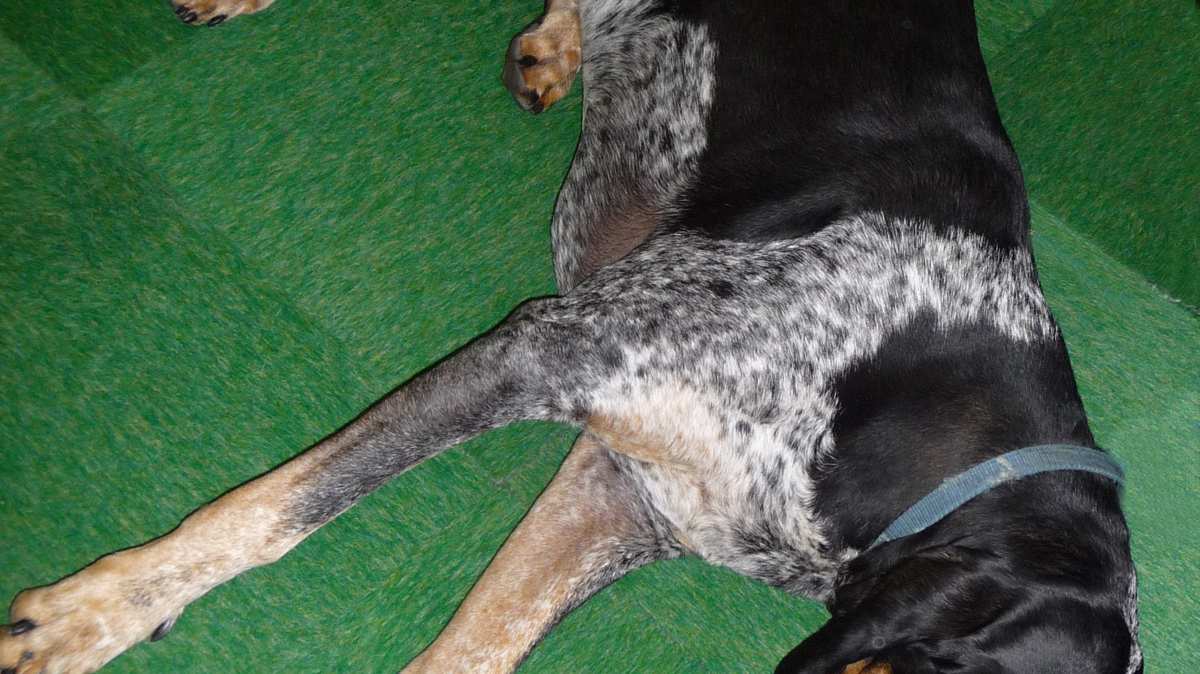Grand Bleu De Gascogne Breed Details
Below are the breed specs and details of the Grand Bleu de Gascogne:

The Grand Bleu de Gascogne is a large purebred scenthound of French origin. It is first and fundamentally a hunting and working breed, and it still embodies many of the physical and temperamental characteristics of its ancient ancestors. It is excellent with people and other dogs though it may show some of its hunting instincts around smaller pets if it hasn't been socialized at a young age. These dogs are very smart and confident; they may be a handful and somewhat difficult to train, but they will surely be their own reward.
Below are the breed specs and details of the Grand Bleu de Gascogne:
Adult males reach a height of 25 inches to 27 inches and weigh between 80 and 100 lbs. Females will reach a height of 23 inches to 25 inches and a weight between 75 and 85 lbs.
These dogs are intelligent and stubborn; they may take more time to train than usual. However, Grand Bleus are friendly and good with kids and love human contact, making them good for families (especially active ones).
These dogs are low maintenance. They will require a minimal amount of brushing/grooming, and a moderate to high amount of exercise, depending on their living environment.
The Grand Bleu de Gascogne is a scenthound with a long legacy that can be traced back to the original scenting dogs of Gaul and the Phoenicia. This breed is one of the two types from which most modern hound breeds have descended. The Grand Bleu is probably most closely related of the Bleu de Gascogne breeds to the ancient hounds of Gascony Province, located on the southwestern coast of France. Dogs of this breed were commonly engaged as a trail hound for hunting large game including wolves, bears, boars and deer.
It is recorded that a pack of these dogs were owned by the 16th century King of France, Henry IV. Furthermore, this breed has a long history in the United States. They have been bred in the U.S. since the 18th century, and there are now more Grand Bleu's there than in France. After the revolutionary war, the French General Lafayette presented a pack of seven Grand Bleus to George Washington, who admired them for their sonorous howl. The Grand Bleu de Gascogne was recognized by the United Kennel Club in 1991.
The Grand Bleu is a dog of noble and refined appearance. It carries itself proudly, and it sports a solid, muscular build. Males are heavier and slightly taller than females. The short, coarse coat is often marked with black patches, and there are usually two black spots on each side of the head that cover the ears and eyes and stop at the cheeks. There are small tan markings above the eyes, on the cheeks, inside the ears, on the legs and under the tail. Their ears are floppy and very large, extending below the muzzle.
The images below represent the coat colors and patterns associated with Grand Bleu De Gascognes.

A trail hound with a calm and persevering attitude, the Grand Bleu is a dog that is excellent both as a worker and a companion. These dogs were originally used to hunt wolves but have since successfully adapted to hunting other animals such as wild boar, deer, fox and hare. This breed possesses a great amount of confidence, endurance, and exceptional intelligence, though this comes at the cost of its stubbornness. These dogs may be difficult to train and may not always want to do exactly what their owner tells them owing to their independence.
Despite this, these dogs are very friendly to humans and other dogs. Some individuals may be very sociable, and others may be more reserved, but they will never be very shy or aggressive. As a hunting and working breed that has long worked alongside other hounds and their handlers, aggression towards other dogs and people is almost unheard of, though they may take chase to small animals. If these dogs are to be living with cats or other pets, it is very important to socialize at a young age.
This breed is low maintenance. Their short coat will not need very much brushing, and these dogs shed a moderate amount. These dogs will be happy lounging about the house most of the day but still require a fair amount of vigorous exercise daily.
These dogs are fairly easy to groom; a brushing once or twice a week should be sufficient. It is important to pay special attention to the dog's ears. As is the case with many floppy-eared dogs, the Grand Bleu de Gascogne's ears are susceptible to becoming dirty and infected, therefore they need to be cleaned regularly.
These dogs are very intelligent and bred to work, so giving them ample mental and physical stimulation is a must. If they are not used for hunting they will love a daily brisk jog or a long walk, and a large yard to roam is a plus but not a must as long as they receive this kind of regular exercise.
These dogs were bred to work and will appreciate living in an environment where they can work alongside their owner(s), but they are also happy to live in a house as long as their daily exercise needs are met. Apartments are not recommended because of their large size, but may be possible is their owner is committed and active.
These dogs are not known to have any hereditary issues and should live between 10 and 12 years. It is important to check these dog's ears regularly for signs of infection.